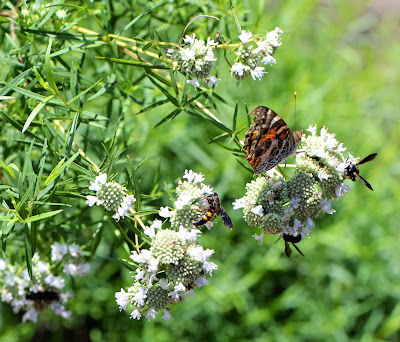Mountain mint is the center of pollinator action in our July garden. This native plant is a staple in many butterfly and pollinator gardens. The genus pycnanthemum means many clustered flowers. At Southern Meadows we grow pycnanthemum tenuifolium commonly called narrow-leaf mountain mint.
Our first plant was purchased at the State Botanical Garden of Georgia's Native Plant Sale many years ago. This perennial is in full flower in mid summer and covered in bees, wasps, butterflies, moths and flies from dawn to dusk. You can watch a short video on my Instagram page
here to see all the pollinators in action.
As regular readers know, a favorite activity of mine is to study the diversity of insects in our gardens and observe which plants support them best. Mountain mint is a winner! Plants that support such a wide variety of pollinators are essential in any garden but particularly in smaller gardens where real estate is at a premium and every plant must be a workhorse. Fortunately, we have plenty of space for plants that are generous in nature.

Many species of wasps come to sip the nectar and gather pollen for their young. Wasps are crucial pollinators. Perhaps not as efficient as bees, they collect pollen grains on translucent hairs on their thorax and abdomen pollinating flowers along the way. Wasps are often disliked by people because they are stinging insects, as many social insects are; however, they are valuable in keeping the ecosystem balanced. They are predators, helping control population of other insects, by laying eggs on their larvae. Some species often feed dead insects to their offspring. [Note: I have never been stung by a wasp in our garden. I am more likely to be stung by a saddleback caterpillars from inadvertently brushing against their hairs that release a venom.]
 |
great golden digger wasp
|
 |
| great black wasp |
 |
blue winged wasp
|
 |
potter wasp
|
Smaller butterfly species are also fond of mountain mint blooms, dancing around from one flower to another.
 |
fiery skipper
|
 |
common buckeye
|
 |
duskywing
|
 |
American Lady
|
Narrow leafed mountain mint staggers the bloom time of the flower clusters providing for a long bloom period. Bees are numerous. From native bumble, leafcutter, and carpenter bees to European honeybees.
 |
carpenter bee
|
 |
bumble bee
|
 |
| leafcutter bee |
This perennial forb is a member of the Lamiaceae (Mint) family of plants. When the foliage is crushed it emits a distinct minty scent. It forms colonies by spreading through rhizomes and like most plants in the mint family it can show vigorous growth. I frequently divide our plants and add them to other flower beds or pass them along to friends (share the love). You may consider growing this plant from seed but beware the seeds are tiny. According to the USDA Natural Resource Conservation Service one ounce of seed contains roughly 375,000 seeds! The NRCS also noted that the seeds are too small to attract birds so if you grow this plant or know someone who does, come fall collect those seeds and start sowing. Seeds should be collected when the black seeds can be shaken out of the old blooms.
 |
mountain mint (front) with rattlesnake master (back)
|
In its natural habitat mountain mints flourish along the woodland edges growing in sun to part sun situations. They are tolerant of dry soil but prefer semi moist soil. Established plants are very tolerant of our typical late summer drought. [Tip] Keeping the soil moist during the earlier part of the summer will go along way in a happy plant. This forb makes a great low growing plant for erosion control too.
Shown above is a grouping of mountain mint growing with rattlesnake master on our full sun slope. These two plants bloom at the same time and create a flurry of pollinator activity. In another part of our garden it grows below American Beautyberry shrub (shown below). It also grows in our meadows and perennial garden beds. It pairs beautifully with many plants and its fine foliage provides interest and a softness to the garden plantings.
 |
| mountain mint and Callicarpa americana |
Other plants in the genus Lamiaceae that share similar growing conditions to mountain mint include bee balm (Monarda), hyssop (Hyssopus officinalis), lamb's ear (Stachys byzantina), lavender (Lavandula), lemon balm (Melissa officinalis), rosemary (Rosmarinus officinalis), and salvia (Salvia). There are 20 pycnanthemum species that grow throughout North America so where ever you reside you should find one native to your area.
















.png)
